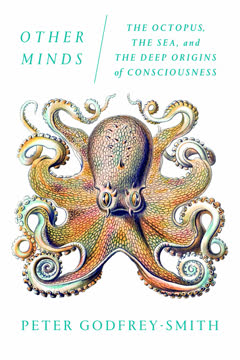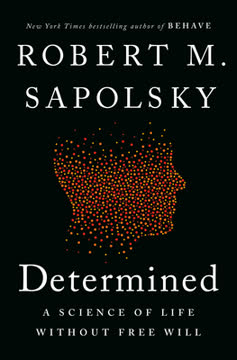Key Takeaways
1. Religion as a By-product of Evolved Cognitive Mechanisms
Religion utilizes and piggybacks onto everyday social-thought processes, adaptive psychological mechanisms that evolved to help us negotiate our relationships with other people, to detect agency and intent, and to generate a sense of safety.
Cognitive adaptations and religion. Our brains evolved various mechanisms to help us survive in social groups and understand our environment. These same mechanisms, originally designed for other purposes, combine to make us susceptible to religious beliefs. For example, our ability to detect patterns and infer causality, crucial for survival, can lead us to see divine intervention in random events.
By-product, not adaptation. Religion itself is not an evolutionary adaptation, but rather a by-product of other cognitive adaptations. This is similar to how reading and writing are cultural by-products of our visual and language processing abilities. The power of religion stems from its ability to engage multiple cognitive systems simultaneously, creating a compelling and memorable experience.
Key cognitive mechanisms involved:
- Pattern recognition
- Agency detection
- Theory of mind
- Social cognition
- Decoupled cognition
2. The Attachment System and Religious Belief
Think of a two-year-old child reaching out to be picked up and cuddled. He extends his hands above his head and beseeches you. Think now of the Pentecostal worshipper who speaks in tongues. He stretches out his hands above his head, beseeching god in the same "pick-me-up-and-hold-me" gesture.
Longing for a caretaker. The attachment system, crucial for human survival, creates a strong need for a protective figure. This same system makes us susceptible to belief in a caring, omnipotent deity. Religion exploits this innate desire for attachment by offering an ever-present, all-powerful parental figure.
Comfort in belief. Religious belief can provide comfort and security, especially in times of distress or uncertainty. This mirrors the way children seek comfort from their parents. The idea of a loving, protective god resonates deeply with our evolved need for attachment figures.
Ways religion mimics attachment:
- God as a father figure
- Prayer as communication with a caregiver
- Belief in divine protection
- Seeking comfort in religious rituals
3. Decoupled Cognition and Theory of Mind in Religious Thought
We humans have the remarkable ability to create and implement a complex interaction with an unseen other—boss, spouse, friend—in our minds, regardless of time or place, in the past or in the future.
Mental simulation. Decoupled cognition allows us to think about entities and scenarios separate from our immediate experience. This ability, crucial for planning and social interaction, also enables us to conceive of and interact with invisible deities.
Understanding others' minds. Theory of mind, our ability to attribute mental states to others, plays a key role in religious thought. It allows us to imagine the intentions and desires of a god, even though we can't directly observe such a being. This capacity for mental attribution is so ingrained that we readily apply it to non-human entities.
Applications in religious thought:
- Imagining God's will or intentions
- Interpreting events as divine messages
- Believing in unseen spiritual realms
- Attributing human-like qualities to deities
4. Hyperactive Agency Detection and Anthropomorphizing God(s)
Why is it you mistake a shadow for a burglar but never a burglar for a shadow? If you hear a door slam, why do you wonder who did it before you consider the wind as the culprit?
Seeing agents everywhere. Humans have a tendency to detect agency – intentional action by a conscious being – even in ambiguous situations. This hyperactive agency detection device (HADD) was likely adaptive for our ancestors, as it's safer to assume a potential threat than to miss one. However, this same mechanism can lead us to see divine intervention in natural events.
Human-like gods. Our brains are primed to understand and interact with other humans. As a result, when we conceive of supernatural beings, we tend to attribute human-like qualities to them. This anthropomorphizing makes gods more relatable and easier to understand, but it's a clear sign of their man-made nature.
Examples of anthropomorphized divine traits:
- Emotions (anger, love, jealousy)
- Decision-making and planning
- Communication through language
- Physical form (in many religions)
5. Minimally Counterintuitive Worlds and Religious Ideas
If you are told that the big oak tree in the park near your home will do your taxes, wash your laundry, fix your car, and tell you what your future stock portfolio will be, you will not even experiment with belief. However, if you're told that the tree will hear your prayer during a full moon, you may be vulnerable to believing.
Balancing familiar and extraordinary. Religious ideas are often minimally counterintuitive – they violate some of our expectations about the world, but not too many. This makes them attention-grabbing and memorable, while still being conceivable. A god that is omniscient but otherwise human-like is more believable than a god with completely alien attributes.
Cultural transmission. Minimally counterintuitive concepts are more likely to be remembered and passed on to others. This explains why certain religious ideas persist across generations and cultures. They strike the right balance between being familiar enough to understand and unusual enough to be interesting.
Characteristics of minimally counterintuitive religious concepts:
- Mostly conform to natural expectations
- Contain a few violations of intuitive knowledge
- Often involve supernatural abilities added to familiar entities
- Are more easily remembered and transmitted than entirely intuitive or wildly counterintuitive ideas
6. Morality, Cooperation, and Religion
We are born moral animals. We don't need religion to keep us from being immoral monsters, as some faiths would have us believe.
Innate moral capacity. Contrary to some religious claims, humans have an innate sense of morality that predates and transcends religious belief. This evolved capacity for moral behavior likely arose from the need for cooperation in social groups. Research shows that even infants display a basic sense of fairness and empathy.
Religion and social cohesion. While not the source of morality, religion can serve as a powerful tool for promoting cooperation and social cohesion. It provides shared beliefs and rituals that can unite communities and encourage prosocial behavior. However, it can also be used to justify in-group favoritism and out-group hostility.
Components of innate morality:
- Empathy and compassion
- Sense of fairness
- Reciprocity
- Harm avoidance
Ways religion influences moral behavior:
- Codifying moral rules
- Providing supernatural enforcement
- Creating shared group identity
- Offering rituals for atonement and forgiveness
7. The Neurochemistry of Religious Rituals
So powerful was the religion our ancestors discovered that if you look closely, you still see echoes of this first religion in all of the faiths on the planet today.
Brain chemistry and ritual. Religious rituals, particularly those involving music, dance, and altered states of consciousness, can trigger powerful neurochemical responses. These experiences can create feelings of transcendence, unity, and intense emotion, reinforcing religious beliefs and social bonds.
Evolutionary origins. The basic elements of religious rituals – rhythmic movement, synchronized group activities, and altered states of consciousness – likely have deep evolutionary roots. These practices may have originally served to strengthen group cohesion and prepare individuals for cooperative activities like hunting or warfare.
Key neurotransmitters involved in religious experiences:
- Dopamine (reward and motivation)
- Serotonin (mood and social status)
- Oxytocin (bonding and trust)
- Endorphins (pain relief and pleasure)
Common elements of religious rituals:
- Repetitive movements or chants
- Synchronized group activities
- Fasting or other forms of self-denial
- Use of psychoactive substances
8. Science vs. Religion: The Ongoing Conflict
There unquestionably is a conflict between religion and science.
Competing explanations. Science and religion often provide conflicting explanations for natural phenomena and human origins. While religion relies on faith and tradition, science bases its understanding on empirical evidence and testable hypotheses. This fundamental difference in approach leads to ongoing tension between scientific and religious worldviews.
Educational battleground. The conflict between science and religion is particularly evident in debates over education, especially regarding the teaching of evolution. Despite legal victories for science education, there continues to be resistance to teaching evolution in many parts of the world. Understanding the cognitive basis of religious belief can help inform these debates and promote scientific literacy.
Key areas of conflict:
- Origin of the universe
- Evolution vs. creationism
- Age of the Earth
- Nature of consciousness and the soul
Importance of science education:
- Promotes critical thinking
- Provides evidence-based understanding of the world
- Encourages questioning and skepticism
- Fosters technological and medical advances
Last updated:
FAQ
1. What is "Why We Believe in God(s)" by J. Anderson Thomson about?
- Scientific exploration of faith: The book provides a concise, science-based explanation for why humans are predisposed to religious belief, drawing on evolutionary psychology and cognitive neuroscience.
- Religion as a by-product: Thomson argues that religious belief is not an adaptation itself, but a by-product of various evolved psychological mechanisms that helped our ancestors survive and thrive in social groups.
- Accessible summary: The book distills complex academic research into an accessible guide for lay readers interested in the origins and persistence of religious faith.
- Focus on mechanisms: It details the specific mental adaptations—like attachment, agency detection, and ritual—that combine to make religious belief nearly universal across cultures.
2. Why should I read "Why We Believe in God(s)" by J. Anderson Thomson?
- Understand the roots of belief: The book offers a clear, evidence-based explanation for why religious ideas are so compelling and persistent, even in the modern world.
- Bridges science and religion: It helps readers see how evolutionary psychology and neuroscience can illuminate the origins of faith, moving beyond simple debates about religion’s truth or falsehood.
- Practical implications: Understanding these mechanisms can help individuals and societies address the negative consequences of religious extremism and dogma.
- Concise and engaging: The book is praised for its brevity, clarity, and engaging style, making complex science accessible to a broad audience.
3. What are the key takeaways from "Why We Believe in God(s)" by J. Anderson Thomson?
- Religion is a by-product: Religious belief arises from cognitive mechanisms evolved for social survival, not from a direct adaptation for faith.
- Multiple mental systems involved: Mechanisms like attachment, agency detection, theory of mind, and ritual behavior all contribute to the formation and maintenance of religious beliefs.
- Religion exploits social instincts: Religious systems tap into our need for community, authority, kinship, and moral order, making them powerful and hard to abandon.
- Scientific understanding can liberate: Recognizing the origins of faith can help individuals and societies move toward more rational, evidence-based worldviews.
4. How does J. Anderson Thomson explain the evolutionary origins of religious belief in "Why We Believe in God(s)"?
- By-product theory: Thomson supports the idea that religion is a by-product of psychological adaptations that evolved for other purposes, such as social bonding and threat detection.
- Fast food analogy: He compares religion to fast food—both hijack ancient cravings (for safety, community, meaning) with supernormal stimuli that are now often maladaptive.
- Survival in groups: The need to cooperate, detect agency, and form attachments in small groups shaped the brain in ways that make religious ideas intuitive and compelling.
- Empirical evidence: The book draws on studies from evolutionary psychology, anthropology, and neuroscience to support these claims.
5. What are the main psychological mechanisms behind religious belief according to "Why We Believe in God(s)"?
- Attachment system: Our need for caretakers and secure relationships is easily transferred to gods or religious figures, making faith emotionally compelling.
- Hyperactive agency detection: Humans are wired to detect intentional agents everywhere, leading to beliefs in spirits, gods, and supernatural forces.
- Theory of mind and intensionality: The ability to imagine others’ thoughts and intentions allows us to conceive of invisible beings with minds like our own.
- Transference and kin psychology: Early relationships with parents and kin are unconsciously projected onto religious authorities and communities.
- Ritual and synchrony: Group rituals harness brain chemistry to create powerful feelings of unity, trust, and transcendence.
6. How does "Why We Believe in God(s)" describe the role of ritual and brain chemistry in sustaining faith?
- Neurochemical rewards: Rituals trigger the release of neurotransmitters like serotonin, dopamine, oxytocin, and endorphins, producing pleasure, bonding, and reduced anxiety.
- Group cohesion: Shared rituals create synchrony and unity, reinforcing group identity and commitment to shared beliefs.
- Costly signaling: Participation in demanding rituals serves as a hard-to-fake signal of commitment, building trust within the group.
- Origins in early societies: The book traces ritual’s roots to hunter-gatherer societies, where song, dance, and trance were central to religious experience and social survival.
7. What is the significance of the "hyperactive agency detection device" in "Why We Believe in God(s)"?
- Evolutionary advantage: This cognitive bias helped our ancestors survive by erring on the side of caution—better to mistake a shadow for a predator than vice versa.
- Foundation for supernatural belief: It predisposes humans to see intention and agency in natural events, paving the way for belief in gods, spirits, and other unseen agents.
- Persistence in modern life: Even today, people attribute agency to random events or objects, reinforcing religious and superstitious thinking.
- Link to anthropomorphism: The tendency to ascribe human-like qualities to non-human entities is central to the formation of personal gods and supernatural beings.
8. How does "Why We Believe in God(s)" address the relationship between religion and morality?
- Morality is innate: The book argues that humans are born with moral instincts, such as empathy, fairness, and reciprocity, which evolved to facilitate social living.
- Religion co-opts morality: Religious systems claim ownership of these moral feelings, providing explicit codes and justifications, but do not create them.
- Mirror neurons and empathy: Neuroscience shows that humans literally feel others’ pain, supporting the idea that morality is hardwired, not solely taught by religion.
- Religion as a moral shortcut: Faith can make moral decision-making easier by providing ready-made answers, but genuine morality requires independent thought.
9. What evidence from neuroscience does "Why We Believe in God(s)" present for the origins of religious experience?
- No "God center": Brain imaging studies show that religious belief activates the same neural networks used for social cognition, theory of mind, and emotion.
- Temporal lobe involvement: Experiments with the "God Helmet" and studies of temporal lobe epilepsy reveal that stimulation of certain brain areas can induce religious or mystical experiences.
- Attachment and self: Religious experiences often involve brain regions associated with attachment, identity, and the sense of self, explaining the emotional power of faith.
- Mirror neurons and ritual: Observing and participating in rituals activates mirror neurons, enhancing empathy and group cohesion.
10. How does "Why We Believe in God(s)" explain the difficulty of abandoning religious belief?
- Deeply ingrained mechanisms: The psychological systems that support faith—attachment, agency detection, group loyalty—are hardwired and operate largely outside conscious awareness.
- Social and emotional costs: Leaving religion can threaten important relationships and social standing, triggering fears of rejection and loss.
- Cultural reinforcement: Societal indoctrination from childhood further entrenches belief, making skepticism or apostasy emotionally and socially challenging.
- Cognitive biases: Self-deception and the tendency to rationalize beliefs make it difficult to critically examine and abandon faith.
11. What are some of the most important concepts and definitions in "Why We Believe in God(s)" by J. Anderson Thomson?
- Attachment: The emotional system that bonds us to caregivers, easily transferred to gods or religious figures.
- Hyperactive agency detection: The tendency to see intentional agents behind ambiguous events, leading to supernatural beliefs.
- Decoupled cognition: The ability to imagine interactions with unseen others, crucial for belief in invisible gods.
- Minimally counterintuitive worlds: Religious ideas are memorable because they are just different enough from reality to be interesting, but not too bizarre.
- Costly signaling: Rituals and sacrifices serve as honest signals of commitment to the group or faith.
12. What are the best quotes from "Why We Believe in God(s)" by J. Anderson Thomson and what do they mean?
- "If you understand the psychology of fast food, you understand the psychology of religion." — Religion, like fast food, hijacks ancient cravings with supernormal stimuli, often leading to maladaptive outcomes in the modern world.
- "We are risen apes, not fallen angels." — Human nature is shaped by evolutionary history, not divine origin, and our minds are products of adaptation, not supernatural design.
- "Our snap judgments are ‘millions of years in the making’ and so is the human propensity to construct and to believe in gods." — The tendency to believe is deeply rooted in evolved mental mechanisms, not simply cultural indoctrination.
- "Religion is a by-product of adaptations that occurred for other reasons." — Faith arises from cognitive systems designed for social survival, not from a specific adaptation for religious belief.
- "This knowledge can free us." — Understanding the true origins of religious belief empowers individuals and societies to move beyond dogma and toward rational, evidence-based thinking.
Review Summary
Why We Believe in God(s) offers a concise overview of the psychological and evolutionary origins of religious belief. Many reviewers praised its accessibility and thought-provoking content, appreciating the scientific approach to understanding faith. Some found it too brief or biased against religion, while others considered it an excellent introduction to the topic. The book examines cognitive mechanisms, brain chemistry, and evolutionary adaptations that predispose humans to believe in supernatural entities. Overall, readers found it informative and engaging, despite its brevity and occasional lack of depth on certain subjects.
Similar Books










Download PDF
Download EPUB
.epub digital book format is ideal for reading ebooks on phones, tablets, and e-readers.




